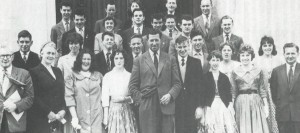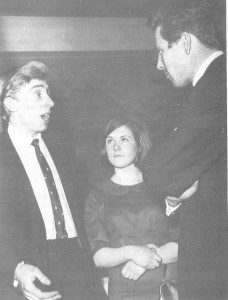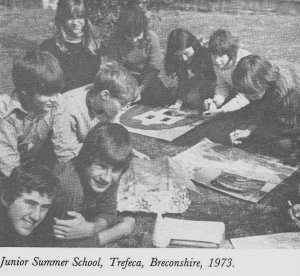History
The History of Youth Cymru
The Welsh Association of Youth Clubs was one of the major voluntary youth organisations in Wales.

Mr Donald Davies, Chairman (centre) with recipients of the Junior Group Leader Certificate. Swansea-A.G.M., 1957.

Roger Kingdom (Chairman) and Ann-Calvin-Thomas (Secretary) of the South Wales Members’ Council in conversation with the President, Lord Snowdon.
Commencing as a girls’ club, organisation, it owes is existence to the initiative of voluntary leaders who formed a number of independent local federations with the object of seeking mutual support.
The Ocean National Colliery Company played a leading role in forming boys’ clubs and girls’ clubs in the Rhondda, Garw and Monmouthshire Valleys, collectively comprising the Ocean National Federation. But elsewhere too, particularly in the “non-special areas,” it was the clubs themselves which formed their own federations with a view to seeking co-operation, discussing common problems, exchanging ideas, arranging, inter-clubs visits and providing services to their mutual advantage.
Two years after the formation of the Cardiff Federation, a meeting was convened by the National Council of Girls’ Clubs. This was held on the 25th of January 1936, at 33 Park Place, Cardiff, mainly as the result of a grant received from the Jubilee Trust by the National Council of Girls’ Clubs for work in the ‘special areas’. Representatives of federations and settlements were invited to attend this important meeting to consider the formation of a South Wales Association of Girls’ Clubs.
In addition to representatives from the federations, a number of other girls’ organisations were present at this historic meeting, but the records do not indicate whether they attended in order to secure membership, or merely to support.
In attendance:
Local Federations
Cardiff & District
Ocean National
Monmouthshire
South Wales Coalfields
Educational Settlements
Merthyr
Bargoed
Pontypool
Risca
Maes-yr-Haf, Rhondda.
Other Youth Organisations
The Girls’ Friendly Society
The Y.W.C.A
Urdd Gobaith Cymru’
South Wales Council of Boys’ Clubs
South Wales Council of Social Services
Dates
1934-Cardiff Federation Formed
1936-South Wales Council Formed
1942-North Wales Council Formed
1943-Welsh Divisional Committee Formed
1954-Re-Organisation in South Wales
1964-Merger of the three constituent bodies
1970-1976-Many more statutory youth clubs sought membership.
Miss Warren, the Organising Secretary, of the National Secretary of the National Council of Girls’ Clubs addressed the meeting. She stated that the Council of Girls’ Clubs in South Wales would provide an essential link between the federations and the National Council and make it possible for combined schemes to be offered, such as holidays, camps and training courses. Additionally, services could be provided for scattered clubs in areas where no federations, as well as the provision of opportunities for women in South Wales to undertake leadership training offered by the National Council.
The birth of this new organisation was not an easy one, and the Celtic trait of being concerned for local identity emerged, when the representative of the Pontypool Settlement stated that she was not in favour of forming a South Wales body, as her organisation, was perfectly capable of co-ordinating the work of local cubs.
In reply, the chairman pointed out that an Association would provide clubs with more scope for development, and prevent settlements from adopting a small minded attitude!
Originally, the major source of income was a proportion of the annual grant received by the National Council of Girls’ Clubs from the Jubilee Trust for work in the ‘special areas’ to be replaced later by a similar arrangement for the disposal of HQ grant received from the Ministry of Education. This initial financial support, apart from a small sum retained for administration, which was passed on to individual girls’ clubs.
Summer School
In 1954, Mr Edward (‘Ted’) Higgins, brought a new dimension to club work in the form of a ‘Summer School’ which he organised for club members and their families. For the next eighteen years, the Harlech Summer School became the focal point for all activities.
A feature of The Harlech Summer Schools in 1958 and 1959 was the production of what quickly became known as “The Chronicles”.
Composed daily in Biblical language by Islwyn Jones and Owen Picton, their production was eagerly anticipated, as were the evening “readings” in the great hall.
Junior Summer School
 In 1972, it was noticed with some concern, that an increasing number of young people under fourteen years of age were now attending affiliated clubs, and in an endeavour to provide for this age group, the first Junior Summer School was planned and directed by Mr. Peter John, West Wales Regional Officer at Coleg Trefeca, Breconshire, when forty junior members thoroughly enjoyed a week’s programme of arts and crafts, music, drama and pony trekking.
In 1972, it was noticed with some concern, that an increasing number of young people under fourteen years of age were now attending affiliated clubs, and in an endeavour to provide for this age group, the first Junior Summer School was planned and directed by Mr. Peter John, West Wales Regional Officer at Coleg Trefeca, Breconshire, when forty junior members thoroughly enjoyed a week’s programme of arts and crafts, music, drama and pony trekking.
In 1973, the second summer school was held at the same venue. The high sprits and the infectious enthusiasm of the youngsters was not only shared during this memorable week, but taken back to their own clubs, and it was noticeable that the clubs involved reflected this influence in their programme of activities.







